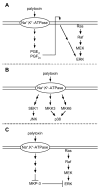Palytoxin: exploiting a novel skin tumor promoter to explore signal transduction and carcinogenesis
- PMID: 16855216
- PMCID: PMC1769420
- DOI: 10.1152/ajpcell.00254.2006
Palytoxin: exploiting a novel skin tumor promoter to explore signal transduction and carcinogenesis
Abstract
Palytoxin is a novel skin tumor promoter, which has been used to help probe the role of different types of signaling mechanisms in carcinogenesis. The multistage mouse skin model indicates that tumor promotion is an early, prolonged, and reversible phase of carcinogenesis. Understanding the molecular mechanisms underlying tumor promotion is therefore important for developing strategies to prevent and treat cancer. Naturally occurring tumor promoters that bind to specific cellular receptors have proven to be useful tools for investigating important biochemical events in multistage carcinogenesis. For example, the identification of protein kinase C as the receptor for the prototypical skin tumor promoter 12-O-tetradecanoylphorbol-13-acetate (TPA) (also called phorbol 12-myristate 13-acetate, PMA) provided key evidence that tumor promotion involves the aberrant modulation of signaling cascades that govern cell fate and function. The subsequent discovery that palytoxin, a marine toxin isolated from zoanthids (genus Palythoa), is a potent skin tumor promoter yet does not activate protein kinase C indicated that investigating palytoxin action could help reveal new aspects of tumor promotion. Interestingly, the putative receptor for palytoxin is the Na(+),K(+)-ATPase. This review focuses on palytoxin-stimulated signaling and how palytoxin has been used to investigate alternate biochemical mechanisms by which important targets in carcinogenesis can be modulated.
Figures

Similar articles
-
Modulation of protein kinase signaling cascades by palytoxin.Toxicon. 2011 Mar 1;57(3):440-8. doi: 10.1016/j.toxicon.2010.11.003. Epub 2010 Nov 9. Toxicon. 2011. PMID: 21070801 Free PMC article. Review.
-
Activation of stress-activator protein kinase/c-Jun N-terminal kinase by the non-TPA-type tumor promoter palytoxin.Cancer Res. 1996 Feb 1;56(3):637-44. Cancer Res. 1996. PMID: 8564984
-
Extracellular signal regulated kinase 5 mediates signals triggered by the novel tumor promoter palytoxin.Toxicol Appl Pharmacol. 2009 Dec 1;241(2):143-53. doi: 10.1016/j.taap.2009.08.021. Epub 2009 Aug 28. Toxicol Appl Pharmacol. 2009. PMID: 19716839 Free PMC article.
-
Palytoxin is a non-12-O-tetradecanoylphorbol-13-acetate type tumor promoter in two-stage mouse skin carcinogenesis.Carcinogenesis. 1986 May;7(5):707-10. doi: 10.1093/carcin/7.5.707. Carcinogenesis. 1986. PMID: 2870823
-
Marine toxins and the cytoskeleton: a new view of palytoxin toxicity.FEBS J. 2008 Dec;275(24):6067-74. doi: 10.1111/j.1742-4658.2008.06712.x. Epub 2008 Oct 24. FEBS J. 2008. PMID: 19016862 Review.
Cited by
-
Ribosomal alteration-derived signals for cytokine induction in mucosal and systemic inflammation: noncanonical pathways by ribosomal inactivation.Mediators Inflamm. 2014;2014:708193. doi: 10.1155/2014/708193. Epub 2014 Jan 2. Mediators Inflamm. 2014. PMID: 24523573 Free PMC article. Review.
-
Palytoxin-Containing Aquarium Soft Corals as an Emerging Sanitary Problem.Mar Drugs. 2016 Feb 4;14(2):33. doi: 10.3390/md14020033. Mar Drugs. 2016. PMID: 26861356 Free PMC article. Review.
-
Marine Polyether Phycotoxin Palytoxin Induces Apoptotic Cell Death via Mcl-1 and Bcl-2 Downregulation.Mar Drugs. 2023 Apr 6;21(4):233. doi: 10.3390/md21040233. Mar Drugs. 2023. PMID: 37103372 Free PMC article.
-
Anthozoan Chemical Defenses: Integrating Compounds, Enzymatic Activities, and Omics-Based Discoveries.Int J Mol Sci. 2025 Jun 25;26(13):6109. doi: 10.3390/ijms26136109. Int J Mol Sci. 2025. PMID: 40649883 Free PMC article. Review.
-
Palytoxin and analogs: biological and ecological effects.Mar Drugs. 2010 Jun 30;8(7):2021-37. doi: 10.3390/md8072021. Mar Drugs. 2010. PMID: 20714422 Free PMC article. Review.
References
-
- Airola K, Johansson N, Kariniemi AL, Kahari VM, Saarialho-Kere UK. Human collagenase-3 is expressed in malignant squamous epithelium of the skin. J Invest Dermatol. 1997;109:225–231. - PubMed
-
- Aizu E, Yamamoto S, Nakadate T, Kato R. Differential effects of various skin tumor-promoting agents on prostaglandin E2 release from primary cultures of mouse epidermal cells. Eur J Pharmacol. 1990;182:19–28. - PubMed
-
- Albanell J, Codony-Servat J, Rojo F, Del Campo JM, Sauleda S, Anido J, Raspall G, Giralt J, Rosello J, Nicholson RI, Mendelsohn J, Baselga J. Activated extracellular signal-regulated kinases: association with epidermal growth factor receptor/transforming growth factor alpha expression in head and neck squamous carcinoma and inhibition by anti-epidermal growth factor receptor treatments. Cancer Res. 2001;61:6500–6510. - PubMed
-
- Angel P, Karin M. The role of Jun, Fos and the AP-1 complex in cell-proliferation and transformation. Biochim Biophys Acta. 1991;1072:129–157. - PubMed
-
- Ares IR, Louzao MC, Vieytes MR, Yasumoto T, Botana LM. Actin cytoskeleton of rabbit intestinal cells is a target for potent marine phycotoxins. J Exp Biol. 2005;208:4345–4354. - PubMed
Publication types
MeSH terms
Substances
Grants and funding
LinkOut - more resources
Full Text Sources
Medical
Molecular Biology Databases

